
July 25, 2020 Ryukyu Shimpo
On the evening of July 24, just after the date one year before the planned start of the Tokyo Olympics, which were postponed because of the coronavirus pandemic, fireworks were launched simultaneously around the country in the hope of adding a bit of brightness and excitement to people’s lives. In Okinawa, around 50 fireworks each were launched at the Itoman fishing port and Energic Stadium Ishikawa in Uruma.
The fireworks were planned by the Junior Chamber International Japan (JC). According to JC, fireworks were launched in 117 locations across 46 of Japan’s prefectures (with the exception of Kagoshima, where they were cancelled because of rain).
(English translation by T&CT and Sandi Aritza)
Go to Japanese
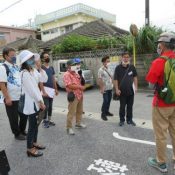
July 27, 2020 Ryukyu Shimpo
Okinawa City—On July 16, the Okinawa City Tourism and Products Promotion Association (chaired by Takashi Shimabukuro) concluded its 15th tour-guide training program, which aims to cultivate leaders to disseminate Okinawa City’s diverse culture and history. With this year’s program conclusion, the total number of its graduates reached 180; about 140 of which registered with the association as certified tour guides, actively working with students visiting on school trips.
Business developments undertaken by the tourism association, such as the “Koza Machimai” and “Walking Tour of KOZA, the Military Base Town” dives deep into the various charms of Koza and has re-energized the city’s tourism from a novel perspective.
The tour-guide training program began fostering leaders in 2013. This year, 13 trainees completed a total of 8 courses, including classes on sightseeing, the city’s current situation, its history, professional code of conduct, and three practice walking tours. Guides’ ages vary, from 20s to 60s. Trainee Shigeru Chibana, 65, resident of Naha City, was born in Okinawa City. After returning to his hometown for the first time in 30 years, he said, “There is no other city with so much charm. I want to give visiting students an illuminating experience during their school trips. This is how I can give back to my hometown, where I was born and raised.” Chibana looks forward to his debut as a tour guide this fall.
According to the association, tourism records for FY2019 indicated about 8,000 visitors and 82 groups visited the city, mainly middle school- and high school-class trips from outside Okinawa, including cultural visits to see Okinawan eisa dance. Mirai Zukeran, who is in charge of the city’s tourism promotion said, “We value encounters. Guides are key to developing repeat clients who have fallen in love with Okinawa and with Koza.” Zukeran has high hopes for the role the tour-guide training program will continue to play.
(English translation by T&CT and Monica Shingaki)
Go to Japanese
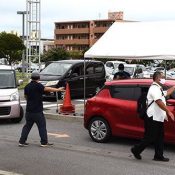
July 26, 2020 Ryukyu Shimpo
Fourteen new cases of COVID-19 were confirmed in Okinawa on July 25, the most single-day cases announced by the prefecture so far. Meanwhile, Okinawa prefecture has come to understand that there are a total of 229 cases from U.S. military personnel on the island, surpassing the total in Okinawa of 186. That day, Okinawa began PCR testing for Japanese citizens who work in the U.S. bases, and over 600 people rushed to the testing site to be tested. While there was relief to be had from the testing, the continued spread of the virus throughout the bases has cast a frightening shadow over the workers.
By July 24, Okinawa had contacted the over 800 people who work at Camp Hansen and MCAS Futenma through organization such as the Okinawa Defense Bureau (ODB) for testing. At the testing site, a community center in Okinawa City, people began lining up at 8:00 a.m., well before the official opening time of 10:00 a.m. A woman who works at Camp Hansen, 66, said, hand to her chest, “Being tested is a small relief.”
By 9:30 a.m. the cars of people waiting to be tested were lined up around the block, causing a traffic jam. Okinawa Prefecture made the decision to move the opening time up by 30 minutes, and started inviting people into the testing site. Test recipients were given receptacles to collect saliva, then waited in the parking lot to hand in their samples. After receiving their tests with nervous expressions, people left briskly.
A woman in her seventies who works at MCAS Futenma said of the spread of COVID-19 among U.S. military personnel, “It’s scary. I was thinking of quitting my job. Since I am older, if I caught the disease it is possible it could become serious. Every day I am nervous, and it strains on my spirit,” she said with a fearful expression.
A man in his fifties that works in a cafeteria for soldiers in Camp Hansen, criticized that starting testing two weeks after cases were confirmed on the bases in Okinawa was too late. “They should have started testing earlier, and considered closing down the workplaces. I still interact with a large number of U.S. military personnel in my job, so this won’t alleviate my uneasiness.”
There were also people who arrived before heading into work. Another man in his fifties who works at Hansen said, “I don’t feel sick, however I am worried that I will pass it on to my family or people around me. The U.S. military should strictly limit the movement of their personnel, and take measures to limit their contact with Japanese employees.”
In order to not exclude those who had come for testing when the planned testing time ended at 2:00 p.m., testing continued until around 3:00. A representative from Okinawa said, “It was more than we expected, but we will prepare to see a similar number of people tomorrow.”
(English translation by T&CT and Sam Grieb)
Go to Japanese
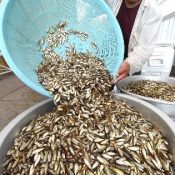
July 22, 2020 Ryukyu Shimpo
Nanjo – On July 21, which corresponds to June 1 on the old lunisolar calendar, a catch of suku (baby rabbit fish), also called the “ocean bonus” was hauled in to Ojima Island in Tamagusuku, Nanjo. Stores on the island that sell the fish were bustling with locals looking to buy.
The fishermen set out from the harbor at 7:00 a.m., spending around 10 hours catching suku. Back at the port, the women of the island and fisherman transfer the freshly caught suku from the boats in baskets to where they are bagged. The sell quickly, flying off the shelves almost as quickly as they are stocked on the shelves in stores, bringing smiles to the faces of fishermen and shopkeepers alike.
Kenichi Nakamoto, 64, owner of the Nakamoto Fish Market, said, “Just today we caught around 100 kg. It is not a particularly large catch, but the taste is, as expected, good as always.”
A 53-year-old woman who bought some suku at Ojimaimaiyu Market said, “Tonight our family is going to try some suku sashimi,” smiling happily.
(English translation by T&CT and Sam Grieb)
Go To Japanese
July 24, 2020 Ryukyu Shimpo
According to the latest National Lifestyle Survey conducted by the Ministry of Health, Labor and Welfare, the childhood poverty rate in Japan is at 13.5%, meaning one in seven children live in poverty. The result indicates no improvement was made since the previous survey conducted three years ago.
The latest survey was conducted in 2019, and does not reflect the effects of the coronavirus pandemic, and it is safe to assume the current situation is even worse. To ensure that children are not forced into instability, the widening economic inequality must be addressed.
The situation is dire in Okinawa, where the childhood poverty rate is twice the national average; the prefectural government estimated that 29.9%, or one in three children, lived in poverty in Okinawa during the fiscal year 2015.
In order to break the vicious cycle of poverty, every child regardless of their parents’ economic situation, must be provided equal education opportunities. However, in reality, economic inequality causes educational inequality.
According to a prefectural survey focused on high school students, during fiscal year 2019, 49% of high school students in economic hardship had part-time work experience, and 88% of parents responded that their economic circumstances did not allow them to afford supplemental learning tools for their children. Poverty deprives students of educational opportunities and crushes motivation, ultimately affecting their career path.
The biggest factor contributing to these issues is the insufficiency of public funds for education. According to the Organization for Economic Co-operation and Development, Japan’s public expenditure allocated for education in proportion to GDP was the lowest among the 35 comparable countries in 2016. Since education expenses are mostly shouldered by families, the parents’ economic situation ultimately determines a child’s access to education.
In order to solve childhood poverty, it is incumbent upon the central and local governments to significantly increase the education budget and reduce the burden on each household.
Meanwhile, many employees have been placed on furlough or have been laid off due to the pandemic, necessitating fast, direct measures to ensure that children receive the education they need.
According to a survey conducted in April by the NPO, Single Mothers’ Forum, 54.4% of single mothers responded that their household income would be reduced or completely lost, due to the pandemic. Households with lower wages and unstable employment conditions are affected most by the pandemic.
Furthermore, household income has decreased among single-parent households in which the parent was forced to take time off from work, due to the temporary closure of schools. Since children no longer have access to school lunches, parents are faced with increased food expenses, leading to reports of children not having access to food.
Schools are increasingly shifting to remote teaching as a countermeasure to the pandemic, but availability of internet access at home may exacerbate educational inequality. These issues of childcare and education need to be resolved before the second wave of the pandemic hits.
It is clear we need increased childcare allowance and child support from the government, free internet access for online schooling, reduced or free tuition, job security for parents with children, and a significant aid package to ensure that impoverished parents are not left behind.
(English translation by T&CT and Monica Shingaki)
Go To Japanese

July 23, 2020 Ryukyu Shimpo
It came to this newspaper’s attention that the Cooperative Associations of Naha Kokusai Dori Shopping Street conducted an examination on July 20 and 21 into the closing of 40 shops on Kokusai Dori (International Street) in Naha City due to the spread of the novel coronavirus. The Cooperative Associations are initiating “International Street Marché” on July 26 to revitalize the shopping street while avoiding the three Cs (closed spaces, crowded places, close-contact), and to have goods sold and foodstuffs supplied on the street. According to the Cooperative Associations of Naha Heiwa Dori Shopping Street, 16 shops on Heiwa Dori (Peace Street) closed on July 22.
There are approximately 470 shops on Kokusai Dori. At the peak time of the influence of coronavirus, 400 or more shops were temporarily closed, and starting in June the number of shops reopening increased. By the time of the examination, 38 of these shops were still temporarily closed. Over the course of four consecutive holidays, about 20 percent of these temporarily closed shops reopened. At the peak time, on Heiwa Dori, too, 179 shops were for the most part temporarily closed, and at the time of this article more than half of these shops had reopened.
One shopkeeper in his 60s managing a restaurant on Kokusai Dori temporarily closed his restaurant for two months starting in April, and reopened in late June. He explained the difficulty of the current circumstances, saying “Our income has fallen 20-30 percent compared to the same period last year; each month we are at about a 300,000 yen deficit”.
The Kokusai Dori Marché is being initiated as an emergency measure of the Ministry of Land, Infrastructure, Transport and Tourism (MLITT) to make possible the selling of goods and supply of foodstuffs that have not been possible in the conventional transit mall. It will be held every week on Sunday. Akihiro Ishizaka, head of the Cooperative Associations of Naha Kokusai Dori Shopping Street, said “We are aiming for a street that offers peace of mind, safety, and a comfortable space that tourists can choose [to visit]”.
(English translation by T&CT and Erin Jones)
Go To Japanese
July 21, 2020 Ryukyu Shimpo
On July 15, the Okinawa Chubu Central Hospital started collecting specimens for antibody surveys to be carried out by the Okinawa Prefectural Government in partnership with the Okinawa Institute of Science and Technology (OIST) for a survey of the state of coronavirus infection in Okinawa. Upon obtaining the consent of patients arriving for emergency care, their blood will be tested for antibodies. The same will be carried out at the Public Kumejima Hospital. Collection of antibodies will start at prefectural hospitals in the northern and southern parts of Okinawa Island, Miyako, and Yaeyama as soon as approval is received from the ethics review committee.
By the end of fiscal 2020, 2,000 specimens are expected to be collected for each of three surveys at the five prefectural hospitals and one public hospital, so that the surveys will include a total of 6,000 specimens. The initial survey will be carried out in July and August.
OIST will be in charge of specimen measurement, and specialists from Kyoto University, Hokkaido University, and Kumamoto University will analyze the data. The state of infections in each region of Okinawa will be ascertained based on the analysis results, and this information will be leveraged in the Okinawa Prefectural Government’s subsequent measures to prevent the spread of infection.
Since some coronavirus cases are mild or symptomless, it is possible that many cases have gone unreported.
The antibody survey aims to check for the presence of immunity in order to discover the likelihood that one has been infected in the past and ascertain the actual state of infections.
(English translation by T&CT and Sandi Aritza)
Go to Japanese
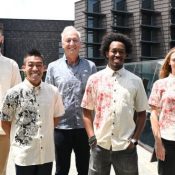
July 17, 2020 Ryukyu Shimpo
Okinawa Institute of Science and Technology Graduate University (OIST) in Onna Village collaborated with the T-shirt brand HabuBox to create a capsule collection of kariyushi wear. A photoshoot was held on campus on July 7. The exclusive designs are based on the OIST logo, which features a shisa dog motif and the village flower, yuna (Hibiscus tiliaceus).
The shirt utilizes natural materials such as linen. The designs are hand-printed by craftsmen, giving it a character not achieved by mass-production.
At the on-campus photoshoot, OIST President Dr. Peter Gruss said, “Kariyushi shirts signify the wearer’s membership to Okinawa; I hope to share the OIST vision with the people of Okinawa with this kariyushi collection.”
The shirts are available in red, black and navy, priced at 9,460 yen each (tax included).
Purchase your kariyushi shirt today at https://habubox.base.shop/categories/2537717.
(English translation by T&CT and Monica Shingaki)
Go To Japanese
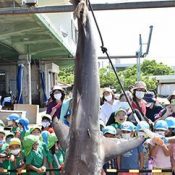
July 18, 2020 Ryukyu Shimpo
Ishigaki – Fishermen from Ishigaki engaged on a two-day shark hunt on July 13 and 14 in the ocean around Ishigaki island. Over the course of the two days, they caught a total of 145 sharks, including species such as tiger sharks, silvertip sharks, and tawny nurse sharks.
On July 14 the captured sharks were unloaded one-by-one at Ishigaki harbor, including the largest, a 358 kilogram, 367 centimeter-long tiger shark. Local nursery school children and tourists who came to watch the unloading reacted in surprise to the sharks with comments like “It’s so big” and “scary.”
Yoshio Miyasato, the president of the Yaeyama Fisherman’s Cooperative pole fishing research council, one of the groups in the city’s fishing village, said, “With the price of fish slumping, the damage caused by sharks has become an increasingly severe problem. There have been many indicators this year of the damage. This hunt will have an effect for around 2 weeks. If we had the budget, I would like to do this around five, six times per year.
Want a taste? A food sampling booth that made kamaboko using a captured shark gets high praise for their tasty treat
Ishigaki – At the Yaeyama Fisherman’s Cooperative’s lot in Ishigaki harbor, where the captured sharks were unloaded on July 14, you can have a taste of kamaboko made with fresh shark meat at a tasting booth. Spectators and fishermen alike enjoyed snacking on the peculiar treat.
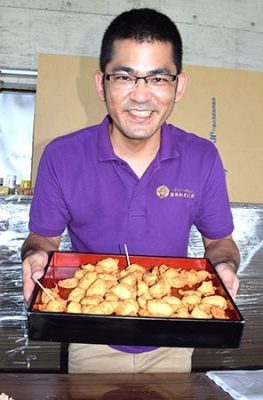
Kinjo Kamaboko CEO Kyuji Kinjo showing off his kamaboko made with tiger shark – Yaeyama Fisherman’s Cooperative
The tasting booth is run by Kinjo Kamaboko (Ishigaki Kamaboko), and the kamaboko was made using a tiger shark caught on July 13. According to CEO Kyuji Kinjo, 42, it was his first time making them.
In the food sampling corner set up in the fishing cooperative’s lot, both spectators and fishermen visited to try a bite of the shark-based kamaboko. The food got good reviews with feedback like, “It doesn’t stink” and “It’s tasty.”
Kinjo said, “It is pretty close to regular kamaboko. I think it can be used to dispel the bad image of sharks that they smell or are scary.”
(English translation by T&CT and Sam Grieb)
Go To Japanese
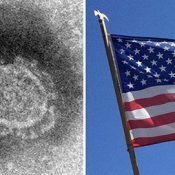
July 17, 2020 Ryukyu Shimpo.
Upon receiving news that cases of persons infected with the novel coronavirus are being confirmed one after another on U.S. military bases, residents of municipalities in the north-central part of Okinawa Island are making one inquiry after another. As apprehension spreads among residents, there is discussion concerning the high likelihood of coming into contact with persons related to the U.S. military, and whether residents will be able to receive PCR testing.
As of July 16 there have been inquiries made in Ginowan City and Okinawa City the central part of Okinawa Island, which hosts Futenma Air Station and Kadena Air Base, concerning the spread of the coronavirus on U.S. military bases. Several instances from restaurants and other businesses near to the military base in Ginowan City have occurred in which persons related to the U.S. military have entered these shops, contributing to residents’ apprehension. As of July 16 there were 25 inquiries concerning the U.S. military renting a civilian hotel in Chatan Town for isolation of reassigned personnel.
As of July 16 residents of Onna Village and nearby Kin Town, which hosts Camp Hansen, contributed to discussions in the northern part of Okinawa Island. In Kin Town, there have been several topics of discussion each day since July 9, and residents are asking questions such as “Is it ok for persons employed by the military to come and go from the military base?” One topic of inquiry was raised on July 15 in Onna Village by a resident who lives next door to a guesthouse, this being: “Foreign persons are also using the guesthouses. How are [residents in the vicinity] supposed to go about receiving PCR testing?”
(English translation by T&CT and Erin Jones)
Go To Japanese










 Webcam(Kokusai Street)
Webcam(Kokusai Street)


